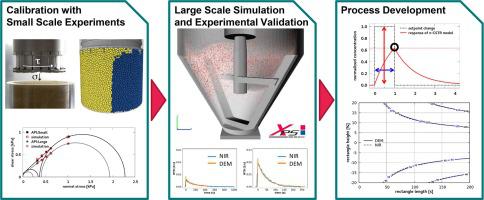International Journal of Pharmaceutics ( IF 5.3 ) Pub Date : 2021-09-02 , DOI: 10.1016/j.ijpharm.2021.121065 Peter Toson 1 , Pankaj Doshi 2 , Marko Matic 1 , Eva Siegmann 1 , Daniel Blackwood 2 , Ashwinkumar Jain 2 , Jenna Brandon 2 , Kai Lee 3 , David Wilsdon 3 , James Kimber 3 , Hugh Verrier 3 , Johannes Khinast 4 , Dalibor Jajcevic 1

|
Continuous powder mixing is an important technology used in the development and manufacturing of solid oral dosage forms. Since critical quality attributes of the final product greatly depend on the performance of the mixing step, an analysis of such a process using the Discrete Element Method (DEM) is of crucial importance. On one hand, the number of expensive experimental runs can be reduced dramatically. On the other hand, numerical simulations can provide information that is very difficult to obtain experimentally. In order to apply such a simulation technology in product development and to replace experimental runs, an intensive model validation step is required. This paper presents a DEM model of the vertical continuous mixing device termed CMT (continuous mixing technology) and an extensive validation workflow. First, a cohesive contact model was calibrated in two small-scale characterization experiments: a compression test with spring-back and a shear cell test. An improved, quicker calibration procedure utilizing the previously calibrated contact models is presented. The calibration procedure is able to differentiate between the blend properties caused by different API particle sizes in the same formulation. Second, DEM simulations of the CMT were carried out to determine the residence time distribution (RTD) of the material inside the mixer. After that, the predicted RTDs were compared with the results of tracer spike experiments conducted with two blend material properties at two mass throughputs of 15 kg/h and 30 kg/h. Additionally, three hold-up masses (500, 730 and 850 g) and three impeller speeds (400, 440 and 650 rpms) were considered. Finally, both RTD datasets from DEM and tracer experiments were used to predict the damping behavior of incoming feeder fluctuations and the funnel of maximum duration and magnitude of incoming deviations that do not require a control action. The results for both tools in terms of enabling a control strategy (the fluctuation damping and the funnel plot) are in excellent agreement, indicating that DEM simulations are well suited to replace process-scale tracer spike experiments to determine the RTD.
中文翻译:

连续混合技术:DEM 模型的验证
连续粉末混合是用于固体口服剂型开发和制造的一项重要技术。由于最终产品的关键质量属性在很大程度上取决于混合步骤的性能,因此使用离散元方法 (DEM) 对此类过程进行分析至关重要。一方面,可以显着减少昂贵的实验运行次数。另一方面,数值模拟可以提供很难通过实验获得的信息。为了在产品开发中应用这种模拟技术并取代实验运行,需要一个密集的模型验证步骤。本文介绍了称为 CMT(连续混合技术)的立式连续混合设备的 DEM 模型和广泛的验证工作流程。第一的,内聚接触模型在两个小规模表征实验中进行了校准:回弹压缩测试和剪切单元测试。提出了一种利用先前校准的接触模型的改进的、更快的校准程序。校准程序能够区分由同一配方中不同 API 粒径引起的混合特性。其次,进行 CMT 的 DEM 模拟以确定混合器内材料的停留时间分布 (RTD)。之后,将预测的 RTD 与使用两种混合材料特性在 15 kg/h 和 30 kg/h 的两种质量通量下进行的示踪剂加标实验的结果进行比较。此外,还考虑了三个保持质量(500、730 和 850 g)和三个叶轮速度(400、440 和 650 rpms)。最后,来自 DEM 和示踪实验的 RTD 数据集都用于预测传入馈线波动的阻尼行为以及最大持续时间的漏斗和传入偏差的大小,不需要控制操作。两种工具在启用控制策略(波动阻尼和漏斗图)方面的结果非常一致,表明 DEM 模拟非常适合替代过程规模示踪剂尖峰实验以确定 RTD。











































 京公网安备 11010802027423号
京公网安备 11010802027423号